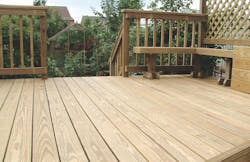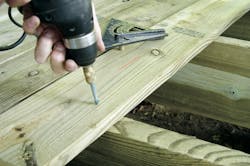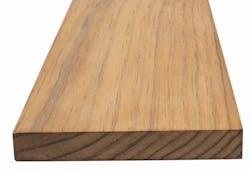TOP TAKEAWAYS FROM THIS ARTICLE
- What are the new (and better?) product options for treated lumber
- A look at the different treatment processes for modified wood
- How builders use modified wood products
- Performance in application
- Cost considerations
Manhattan-based architecture firm Amalgam Studio recently completed a long, linear house that sits on 120 acres in New York’s Hudson River Valley. Perched on a hilltop, the 5,000-square-foot home features airy rooms with high ceilings, exposed timber beams, and strategically positioned windows that draw in natural light (see photo, below).
For the exteriors, Amalgam Studio drew inspiration from traditional barns nearby. As a result, the home has a rectangular form with timber framing and a gabled roof. But instead of traditional wood siding and a metal roof, the architects used modified wood exterior cladding and roof materials from Kebony, choosing to leave the wood unsealed in its natural state so it would develop a gray patina over time.
If you haven’t heard of Kebony, don’t fret. It’s one of a handful of new(ish) exterior-grade wood products that purport to offer enhanced performance compared with traditional pressure-treated lumber. Other brands include:
- Lignia Wood Company
- Thermory USA
- Accoya
- Nova USA Wood Products
- Well Done (Westwood Timber Group)
Such products are either treated with what the manufacturers say are more environmentally friendly chemicals or with alcohol from agricultural waste, or are processed using heat and steam. Whatever the specific treatment process, the producers promise more or less the same things: rot and warp resistance, protection from decay, and a more attractive appearance.
What’s more, they position the material as an alternative to tropical hardwood decking and cladding, as well as traditional pressure-treated pine and fir.
Pressure-Treated Lumber: the Tried-and-True Standard
Pressure-treated lumber is, of course, an undisputed workhorse in home building. By all measures and in almost all residential construction sectors, it’s the most-used material in several outdoor applications. According to the 2019 Builder Practices Survey by Home Innovation Research Labs, treated wood accounted for 40% of all decking material used in 2018, 38% of deck railings, 28% of porch railings, and 96% of vertical fencing material.
In addition, home builders use pressure-treated lumber for all manner of applications in their homes, including raised-wood foundations, sill plates, structural components under decks, permanent wood foundations, walkways, retaining walls, and other landscaping structures. Pressure-treated wood excels—even in ground contact—and contractors and homeowners love its wide availability and affordable price.
“Pressure-treated wood is notably cheaper than cedar, redwood, and other types of wood,” writes Bethesda, Md.-based Design Builders on its website. The company, which designs and builds home additions and high-end outdoor living spaces, adds: “And, because of its durability, you’re much less likely to experience a need for costly repairs in the future. It is a great choice for those operating on a smaller budget.”
Southern yellow pine’s unique cellular structure has made it the preferred timber species for pressurized treatment with wood preservatives because they penetrate the wood deeply and uniformly, says the Southern Forest Products Association, a nonprofit trade association representing southern pine lumber producers.
That effective penetration of preservatives renders southern pine useless as a food source for fungi, termites, and micro-organisms, the group says on its website, adding that research shows southern pine can be expected to last for “many decades when properly treated and installed for its intended use.”
Downsides of Pressure-Treated Lumber
But pressure-treated pine has limitations when used for aesthetic projects such as fences, gazebos, and decks. “Since this type of decking material is made from natural wood, it will inevitably splinter with time,” Design Builders cautions on its website. After being outdoors for six to 12 months, the company says, treated decks may also experience checking, wherein exposure to alternate cycles of wetting and drying cause the wood to begin to dry out and split apart.
In short, pressure-treated wood requires some after-market maintenance by homeowners to protect it from splintering, checking, and fading by applying stain and a penetrating sealer. “Without proper care,” Design Builders says, “the wood will retain stains and blemishes from leaves and debris.”
The Next Big Thing in Building With Wood
A new generation of wood aims to eliminate the downsides of traditional treated wood. Kebony, for example, says that once its lumber is altered to resist warping, rot, decay, and pests, the wood is maintenance-free and stable. And it’s all due to Kebony’s treatment process.
“Kebony is a modified wood, meaning the cell structure has been permanently altered through our process of furfurylization,” says Andy Hehl, U.S. manager for Kebony USA. The two-step process includes injecting furfuryl (aka, plant-based alcohol) into the lumber’s sapwood, followed by a curing stage in which the wood is placed in a special kiln, which initializes the polymerization of the furfuryl alcohol and the wood cells.
The polymerization process thickens the wood’s cell walls, Hehl says, making the material more durable (Kebony offers a 30-year warranty for exterior above-ground use), harder (it’s about the same hardness as hard maple), and more stable (50% more than ipe, a popular Brazilian hardwood). The heat also caramelizes the wood sugars, resulting in a color change throughout the board from a light blond to a dark brown.
Kebony primarily treats radiata pine, a timber species native to California’s central coast and Mexico, for cladding, decks, roofs, general construction, and other design projects where looks and precision matter, the company says.
A relatively new player in the North American market is Lignia, a high-performance modified timber product from the United Kingdom. Lisa Ayala, U.S. sales manager for Lignia Wood Company, says the brand includes Lignia Standard, Lignia Fire, and Lignia Yacht.
“It’s another modified timber product that has come on the market and one that has been studied for years,” Ayala says. “It has taken its time to come on the market as an alternative.”
Lignia’s products are modified using a resin impregnated into the wood under pressure. But, unlike traditional pressure-treated lumber, the process gets to the heart of the wood, Ayala says, so the material’s end-use performance is better.
The result of that process, the company says, is a highly durable, dimensionally stable wood with 50-year protection against rot and fungal decay in above-ground applications, as well as defense against termites. The resin-injection process also increases the wood’s density and hardness.
Made using softwood species, Lignia is ideal for a variety of applications, including decks, cladding, and floors.
Another option is heat-treated lumber from companies such as Thermory USA, which uses only heat and steam, without any chemicals. The company heats its lumber to approximately 400º F, which alters the wood’s cellular structure, reducing moisture-related movement and increasing rot resistance by lowering the wood’s sugar content, which provides food for the molds and fungi that cause decay. The heat treatment also changes the wood’s color to an exotic brown, which gradually ages to a consistent silvery gray.
“We keep our story simple and short,” says Kevin DeMars, principal of sales at Thermory USA. “We use heat and steam, and we improve the wood’s color and stability.”
Thermory offers three treated timber species to the U.S. market: Scots pine, Kodiak spruce, and white ash, the latter responsibly harvested from well-managed, sustainable forests and offering similar hardness to oak, the company says. Products include decking, cladding, and porch flooring. The company says that, depending on the wood species, its products are rated to offer rot resistance for 20 or more years.
Durability is just one reason why Ted Hobson, designer and estimator at Toronto-based Allweather Landscape Co., specifies Thermory’s lumber for his projects. “You don’t have to treat it periodically, though it will gray a bit,” he says, adding that an oil-based finish with UV protection will preserve the material’s darker tones, stabilize the wood, and reduce any surface cracking.
Hobson also likes the sustainability of heat-treated ash. He used to specify ipe, but says he has issues with the wood being harvested from old-growth trees.
Thermally modified wood may be relatively new to the U.S. market, but it has been used in Scandinavia for more than 70 years and in other parts of Europe and in Japan for almost 20 years. The product is now gaining acceptance in the U.S.
Cost Factors in Building With Wood
Deck builders that use these new modified or treated-wood products, and the architects that specify them, say the materials deliver on their promises.
But that performance comes at a cost. Despite being made from softwoods, modified or heat-treated lumber behaves more like an exotic tropical hardwood, and price points are typically in the same range as high-end composites and hardwoods. The most affordable heat-treated wood would cost a builder about $4 per linear foot, while pressure-treated pine can cost just $1 per linear foot (depending on the thickness).
New-generation manufacturers are working to balance that cost premium. Thermory boards, for example, are often wider than composites and other hardwood options (thus requiring fewer boards) and have an end-matched joint system that allows for faster installation and less waste. The boards also are knot-free, with a fine appearance compared with traditional treated lumber.
Kebony’s products are similarly priced. “Kebony is a high-end product that mostly is used in high-end residential and custom homes or commercial applications,” Hehl says. “Due to its initial cost, production home builders have yet to find the value. It’s not for everyone, as it is expensive up front.”
Still, manufacturers say there are ways for builders to be more inventive in incorporating these new products. For one, builders can apply the lumber strategically in smaller applications that are aesthetically focused—such as entry fencing and landings.
Even so, it is an uphill battle to achieve mainstream acceptance. Production builders are apt to think about material selection in terms of price rather than value because buyers approach the issue in a similar fashion. But for those builders that are willing to make the effort to convince buyers of the benefits, there is opportunity.
“I challenge the life-cycle costs in comparing modified wood products with lower-cost materials,” says Kebony’s Hehl. “But, as we all know, budgets are budgets in production homes. However, where a client desires the look and feel of real wood, without the typical maintenance, and can feel good about it being an environmentally friendly choice, Kebony is a great option.”









